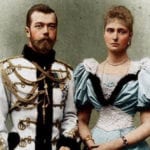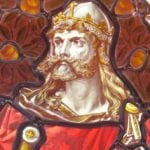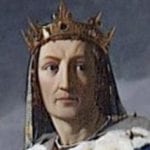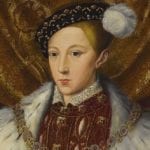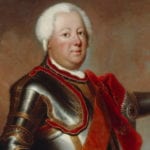 Misconceptions
Misconceptions  Misconceptions
Misconceptions  History
History 10 Amazing Roman Epitaphs
 Weird Stuff
Weird Stuff 10 Niche Subcultures That Are More Popular Than You Might Think
 Mysteries
Mysteries 10 Tragic Disappearances and Deaths in Joshua Tree National Park
 History
History 10 Ways Childhood Really Sucked in the Old West
 Music
Music 10 Name Origins of Famous Bands from the 1990s
 Religion
Religion 10 Biggest Turnarounds by the Catholic Church
 Weird Stuff
Weird Stuff 10 Unbelievable Times Laws Had Unintended Consequences
 Humans
Humans Ten Historic Women Who Deserve Way More Credit Than They Got
 Movies and TV
Movies and TV 10 Films That Spawned Major Lawsuits
 Misconceptions
Misconceptions 10 Phony Myths and Urban Legends That Just Won’t Die
 History
History 10 Amazing Roman Epitaphs
 Weird Stuff
Weird Stuff 10 Niche Subcultures That Are More Popular Than You Might Think
Who's Behind Listverse?

Jamie Frater
Head Editor
Jamie founded Listverse due to an insatiable desire to share fascinating, obscure, and bizarre facts. He has been a guest speaker on numerous national radio and television stations and is a five time published author.
More About Us Mysteries
Mysteries 10 Tragic Disappearances and Deaths in Joshua Tree National Park
 History
History 10 Ways Childhood Really Sucked in the Old West
 Music
Music 10 Name Origins of Famous Bands from the 1990s
 Religion
Religion 10 Biggest Turnarounds by the Catholic Church
 Weird Stuff
Weird Stuff 10 Unbelievable Times Laws Had Unintended Consequences
 Humans
Humans Ten Historic Women Who Deserve Way More Credit Than They Got
 Movies and TV
Movies and TV 10 Films That Spawned Major Lawsuits
10 Unfortunate Fates of English Kings
Historically, the early English kings have a reputation for living high on the hog, and pleasing themselves at the expense of the people they ruled. It was not always so. In the middle ages many of them missed out on a trouble free reign culminating in a State Funeral. We know very little about the first several hundred years of the Anglo-Saxon era. The earliest written records were no more than inventive lists of rulers who established separate kingdoms. The Saxons settled in the west, the Anglos in the east and north, and the Jutes on the Isle of Wight and the opposite mainland. They probably thought of themselves as separate peoples, but they shared a common language and similar customs.

One of those customs was fighting everyone in sight. A king’s power depended on his ability to win battles and so gain land and treasure to give his supporters. He was obliged to keep fighting. If he didn’t he would find himself out of a job or deprived of his life; probably both. The power of any kingdom was only as solid as the strength of its king in battle.
To be able to cut down several enemies in quick succession, when in a tight spot, and to be a more efficient killer than one’s subordinates, was essential for a king living in a society which regarded warfare as the natural way of life. What was gained by the sword needed to be defended by the sword; of the eight kings who ruled Northumbria between 600 and 700, six died in battle.
One successful monarch was Aethelbald of Mercia, a kingdom that was an amalgamation of 30 different tribes. In a style that was typical of the era, he usurped the throne from his father Aethelwulf while the old man was visiting Rome. By 731 he controlled all England south of the Humber, and was styled ‘King not only of the Mercian’s but also of all the provinces which are called South English’. However, his supremacy was neither easily won nor stable and he had many enemies. St Boniface, Archbishop of Canterbury, for example, constantly reproached him for not taking a wife and instead fornicating with nuns.
Aethelbald did marry eventually. On his way back from Rome his father had married Judith, the thirteen-year-old daughter of the Frankish king Charles the Bald, and when his father died Aethelbald took her for his own wife. Even that didn’t satisfy the clergy, who castigated him for marrying his stepmother (she was by then an ancient 15 year-old). The marriage was annulled and the girl returned to France, where her own father, because her marriage had been deemed incestuous, sent her to a nunnery. In a rare breach of Anglo-Saxon fidelity (but not a unique one) Aethelbald was murdered by his bodyguard at Seckingham near Tamworth.
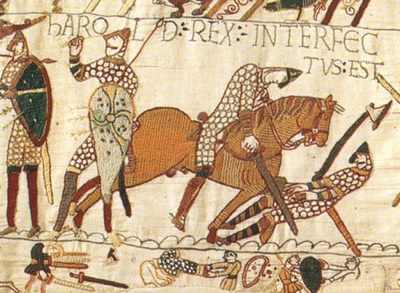
The image of the last Anglo-Saxon King on the hill above Senlac, staggering back with an arrow in his eye, has come to epitomize the drama at the battle of Hastings. It is graphically illustrated on the Bayeux Tapestry – a piece of embroidery 70 meters long created by the women of Canterbury in the early 1070s (so it should really be called the Canterbury Tapestry), and then taken to France.
But this tapestry is not the reliable witness that it seems. The stitching we see today is not necessarily the original, and indeed some of it might be described as a stitch-up. In the years of its existence, two major tracings and a photographic record of the tapestry have been made, so we have three sets of images, dating from 1729, 1819 and 1872 – and there are some dramatic variations. Swords and stirrups appear and disappear, a griffin becomes an angel, and most significantly the depiction of Harold’s slaying are altered.
In 1729 the King has his arm raised and appears about to hurl a spear. In 1819 the shaft of the spear has sprouted a flight of feathers, to become an arrow pointed towards his forehead. Fifty-three years later the angle of the arrow has shifted downwards to point directly at his right eye, so it would seem that occasional restoration work coincided with trying to improve the story.
The truth may be less complicated. According to Guy, Bishop of Amiens, the crucial moment came when the Normans finally broke the Saxon shield-wall. With Harold and a few of his faithful retainers still holding out, William handpicked a hit squad to go and hack him down. Four knights overpowered Harold, one striking him in the breast, a second cutting off his head, while another disemboweled him. We are then told that the fourth knight cut off one of the Saxon kings legs, but the standard battlefield mutilation was full castration, so the bishop’s account was probably being polite.
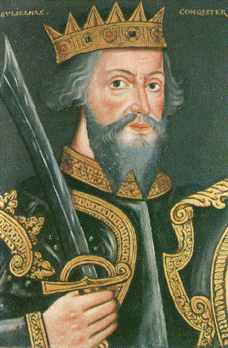
During his lifetime William I was not known as the ‘Conqueror’, his nickname was ‘William the Bastard’, owing to the scandal of his birth when his father had an affair with a lowly tanner’s daughter. But since he was a ruler who thought nothing of having a man’s tongue ripped out and nailed to his front door, people didn’t call him that to his face.
There was oppression in England after the conquest, but this was a consequence of the new king’s need for security as much as anything. William subdued the south and east easily, but the year after Hastings his former ally, Count Eustace of Boulogne (brother-in-law to Edward the Confessor), tried an invasion of his own and was only stopped by the formidable nature of Dover castle.
Harold Godwinson’s sons tried a landing in 1068, and there were more attempts the following year. The most dangerous of these saw a Viking army joining up with the northern earls. They seized York and declared independence, while in answer William took his own army north and began killing everyone who lived there.
The ferocious ‘Harrying of the North’ in 1069 was designed to punish and deter, and it devastated the north of England in a broad swathe from York to Durham. Villages and crops were burnt and livestock slaughtered. Those who escaped a quick death at the hands of the royal army faced a slow one by starvation. During the winter of that year many people turned to cannibalism. The death toll has been estimated at 150,000, and the destruction left much of the area depopulated for generations.
From 1066 to 1204 most of the great Norman barons, including King William I, had estates on both sides of the Channel, and they frequently had to return to Normandy to put down rebellions. Whilst burning out the inhabitants of Mantes in 1087, the Conquerors horse shied at the flames and the pommel of his saddle inflicted a fatal rupture to an already sick man of sixty-one years.
The King had a very corpulent figure when he died, and his corpse swelled even larger during its transit to the abbey of St Stephen in Caen for burial. It became so bloated that it wouldn’t fit the coffin prepared for it, and heavy-handed attempts to force the issue resulted in bursting his belly. It follows that William the Conquerors funeral was less than a sweet-smelling affair.
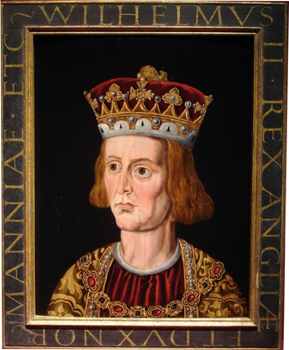
Robert, the Conqueror’s eldest son, was given the dukedom of Normandy. William Rufus, the second son became king of England. He was a dashing warrior, but he was cruel, he was a liar and he was greedy (he was also homosexual, which was a definite negative with the Church in those days).
Rufus treated the priesthood with contempt and seemed to glory in wickedness. The filling of a Bishopric was a lengthy business, and whilst it was vacant a trustee collected the revenues on behalf of the next bishop. Rufus liked this system. The revenues were directed straight into his own treasury, and at the time of his death Rufus was enjoying the incomes from twelve abbeys that he deliberately kept without an Abbot.
In an incident that will always remain a mystery, he died in 1100, killed by an arrow while hunting in the New Forest (Strangely, his favourite nephew was killed by an arrow in the same place three months previously). Evidently he was in the sole company of one William Tyrrell. Tyrrell wasn’t sure that his claim that he had nothing to do with the kings death would be believed, and he fled abroad, but even when feeling safe he denied anything to do with murder.
So was it a hunting accident or an assassination? No one really knows. People cared so little they never bothered to inquire too deeply as to what had happened. Disposal was left to a humble charcoal burner who, on the payment of a couple of coins, dumped the king’s body in his cart and took it to Winchester Cathedral. There, because Rufus had been king, he was buried under the floor, but there was no great ceremony. A year later the tower of the cathedral collapsed, destroying his tomb.
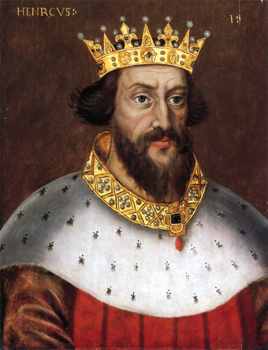
Henry, the Conquers youngest son, leapt onto the throne and he quickly went to war with his brother Robert and added Normandy to his cap. Poor Robert spent the next twenty-eight years shut up in Cardiff Castle as a captive. But we know from surviving accounts that considerable amounts of money was spent on his food and clothes, so he can’t have been treated too harshly, and he lived to the ripe old age of eighty.
Henry I was quite an effective king, and all over England there was peace and law. He had little interest in living large and lavish, and concentrated on advancing the nations administration. One of the ways he raised money was by selling charters to towns. Charters were a special privilege that allowed town walls to be built, and for those living inside them to elect their own local councils.
Also during his reign the Court of the Exchequer was formed to handle financial matters, taking its name from the checked cloth on which the accounts were calculated. He was the last king for four hundred years to leave no debts behind him when he died. He passed away in 1135, apparently from eating too many lampreys (a small parasitic eel-like fish that latches onto trout and salmon, considered a delicacy of cuisine at the time), which is a warning to everyone to go easy on the lampreys.
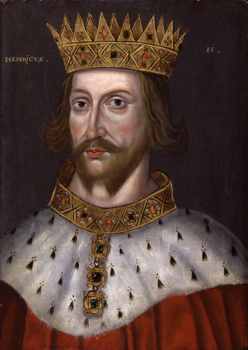
Henry II was one of the greatest kings to sit on the English throne. He was an energetic, intelligent and determined operator who ruled for thirty-five years over a huge swathe of territory. He brought peace and order to a war-torn England, defeated rebels on all fronts, and set down the principles of English law. His father had developed a habit of wearing a sprig of bright yellow broom in his hat, from which came his nickname of ‘Plantagenet’, and Henry made the name his own.
Including his fathers estates, his kingdom not only encompassed England and Normandy, but Brittany and the duchies of Anjou, Touraine and Maine, in north eastern France, too. Henry’s marriage to Eleanor of Aquitaine added to this her lands in south-western France, and their domain then stretched from the Scottish borders to the Pyrenees; a realm bigger in area than that ruled by the French king. This was embarrassing for the French, because William the Conqueror had been no more than a French duke, so the King of England was still technically a vassal of the French monarchy.
Later, when an aging man, Henry began to show favouritism to his youngest son John (nicknamed John Lackland because he had been promised no great inheritance).The elder sibling, Richard (later called the Lionheart), became fearful for his promised kingdom and allied with his fathers greatest rival, King Phillip of France, and invaded Anjou, the Plantagenet heartland. They overran Maine and Tours, and Henry made such a mess of clearing the ground before the citadel at Le Mans, he accidentally burnt down the town.
Defeated, weak, ill and deserted by almost everyone, Henry sent John off to safety in Normandy while he galloped off through the forest towards a stronghold at Chinon. Richard followed his father, blowing a hunting horn as if he were chasing an animal. Henry became too weak to resist, and at Chinon he surrendered to his son. As an agreed part of the terms he was shown a list of those nobles who favoured rebellion against him, and on the top of the list was John, the younger son whose interests he’d been trying to protect.
He gave up the fight against his sickness, saying: ‘Let things go as they will, I shall struggle no longer.’ A few hours later he was dead. Once he had been the greatest king in the west, now he was nothing. His servants at once ran off, after first stealing everything they could, including the clothes off his body. A handful of faithful knights arranged for his burial at a convent. They had to dress him in makeshift finery; a crown of gold lace from a woman’s dress, and a lead scepter taken from a statue.

Edward the Second is famous for being cuckolded by Mel Gibson and losing the Battle of Bannockburn. He was certainly a feckless playboy who shared a close relationship with one Piers Gaveston (Piers wasn’t thrown out of a window, he was only thrown out of the country). When Edward became king he recalled Gaveston and made him Earl of Cornwall. Being lower-class, foreign and gay, the kings boyfriend was always going to have to work on his popularity at court. But he didn’t bother. Instead, the chirpy Gaveston began a scornful teasing campaign at his success towards all the other noblemen, all of whom had short tempers and long memories.
A king was expected to marry, so the year after his father’s death Edward took as his wife Isabella, the beautiful 13-year-old daughter of the French king. The central issue of the ‘Braveheart’ movie, William Wallace’s sexual liaison with Queen Isabella is improbable. She would have been about 10-years-old and unmarried at the time of his execution.
Edward took the opportunity to give large numbers of wedding presents to Piers Gaveston, who proceeded to maliciously flaunt them in front of their donors. This was finally too much for the barons at the royal court. They later sought out the insolent young man at Scarborough Castle, dragged him off to a hillside and cut off his head.
Years passed. The times were desperate, drenched with famine and war. All looked to the king, for it was a kings duty to lead a nation in times of strife. Unfortunately Edward II had little inclination or expertise for it, and simply consoled himself in the company of a new friend named Hugh le Despenser. A despairing population increasingly looked to Edward’s estranged wife, Queen Isabella, to develop a movement against her listless husband.
Whilst on a trip to France with her twelve year old son (Edward III), she fell in love with a disenfranchised marcher lord named Roger Mortimer, and together they hatched a plot to place the younger Edward on the throne, with themselves serving as co-regents. In 1326 the Queen, who was niece to the Count of Hainault, was able to return with her paramour and a band of German mercenaries. The country rose in their support and Edward II fled from London.
After the popular accession of his young son, there was no place for a deposed monarch like Edward II and he was eventually confined in Berkeley castle. The chances are he would have given no more trouble, but one day, probably at the instigation of Mortimer, his gaolers murdered him. In the village of Berkeley tales were told of hideous screams emanating from the castle, but it was many years before the truth was known. Edward had been killed ‘with a hoot brooche (hot meat-roasting spit) putte thro the secret place posterialle’.
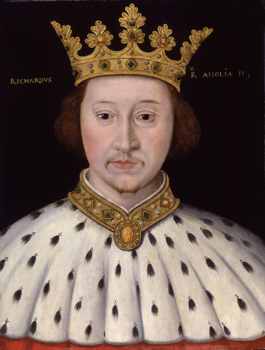
This king started out with great promise. At the age of fourteen he fearlessly rode out to meet thousands of disenchanted peasants who were in rebellion, and concluded the day by leading them out of London and sending them home. Facing down the rebels in 1381 was Richard’s one and only hour of glory. In adulthood he proved to be a bad tempered, dishonest and vain sovereign, and the first king to demand he be addressed as ‘your majesty’.
He married Anne of Bohemia, a sister to King Wenceslas the Good, whom he adored, but after her death, during a wave of plague in 1394, he became increasingly irrational. Two years later he wed the French King’s daughter, Isabella, but it wasn’t a hit, possibly because she was only six.
Richard was afraid of John of Gaunt, the last survivor of the days of the Black Prince. The immensely wealthy and influential John was the effective centre of power, and the key figure in the royal family tree in those days. His lineage would later be quoted by the Tudors in the Wars’ of the Roses, to back up their legitimate claim to the throne.
When the old man died in 1399, Richard was bold enough to confiscate his vast estates, which had been promised to John’s son, Henry Bolingbroke. In doing this he made one enemy too many. Henry was a tough character with many friends, and none of them felt safe if the great Duchy of Lancaster could be seized at the royal whim.
Since the English were a warlike race, Richard planned to go Ireland, where English settlers had been driven back to a small pale around Dublin. This could have been done, but in Ireland there was no worthwhile plunder for a rampaging army. When Richard made a visit there to assess things Henry Bolingbroke turned up with a force of mercenaries, and by the time the King reached Flint Castle in Wales on his return journey, he found himself opposed by 60,000 men.
Lacking enough loyal nobles to fight himself out of trouble, Richard was compelled to surrender to his cousin. Henry had started out with the intention of just reclaiming his inheritance, but the unpopularity of the King among the nobles of England was such that his arrival developed into a full blown takeover.
A short time later Richard abjectly handed over his crown and was imprisoned in Pontefract Castle. He probably knew he hadn’t long to live. The official version is that he went on hunger strike, and Henry displayed the dead corpse to prove he hadn’t been physically harmed. However, it’s likely he was purposely starved to death or poisoned. With the connivance of Parliament, now as strong as it had ever been, Henry Bolingbroke was then installed as King Henry IV. He addressed his Parliament in English, the first King to ever do so.
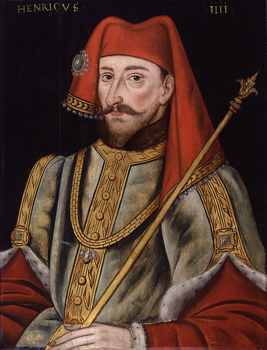
Henry Bolingbroke, now Henry IV, had been talked into seizing the crown, and he didn’t particularly enjoy being King. He came to learn that anyone who seizes the crown is likely to face attempts by others to seize it from him. He was constantly troubled by rebellions, and was so nervous of assassination he sometimes slept in his armor when on campaign.
When he became older he began to suffer from poor health, and his son (later, Henry V) took more and more responsibility on himself, as his father slowly rotted with leprosy, or possibly syphilis. Either way, the poor man was pretty much falling to bits.
During his illness he had been comforted by the prophecy that he would die in Jerusalem, and he swore that when he felt well enough he would go the Holy Land. One day, in 1413, he passed out while praying in Westminster Abbey, and his courtiers carried him to the apartments of the Abbot. “Where am I?” he asked when he briefly revived. “In the Jerusalem Chamber at Westminster,” came the reply.

Oliver Cromwell – What! Hold on, Cromwell was not a king.
Strictly speaking that’s true, but his friends did suggest that, since he commanded 40,000 war hardened veterans, he could easily take the crown and give birth to a new dynasty. He refused, of course, and took the title Lord Protector, which was okay because it was just like having a king, anyway. Since the Puritan Parliament failed to find a way of governing the country sensibly, he dismissed it and ruled as an autocrat, just as the Stuart kings had done.
After much dour pondering, in 1547 Parliament had first ensured the Catholic sounding ‘mass’ was taken out of Christmas and changed the name to Christ-tide. It then quickly prohibited its observance altogether. It also abolished feasts at Easter and Whitsun, and ordered a monthly fast. When Parliament ordered a fast day, soldiers were authorized to enter private houses and confiscate any meat found in the kitchens.
Parliament would not allow dancing, not even around a Maypole on a village green, and they closed all the theaters in London. They were very strict about the observance of Sunday, too, and forbade the playing of sports and games on that day. Even sex was deemed sinful if it was enjoyed. Cromwell didn’t instigate any of these changes, but the rules were in force when he gained power and they remained unchanged until the restoration of the monarchy.
Oliver Cromwell died of malaria in 1658, a disease he probably contracted during his Irish campaign. His body was preserved, and after the Restoration it was ripped from its tomb and hung on public display from the gallows at Tyburn (present day Marble Arch). Later it was dismembered and the body thrown into a pit dug for the disposal of common criminals. The head was stuck on a stake, and for thirty years it decorated the front of Westminster Hall. Afterwards, it was passed around the town to be used as a conversation piece at high-society parties.

